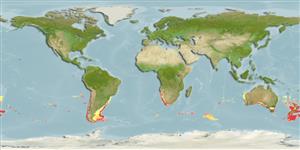Teleostei (teleosts) >
Gadiformes (Cods) >
Macrouridae (Grenadiers or rattails)
Etymology: Coelorinchus: Greek, koilos = a hollow + Greek, rhyngchos = jaw (Ref. 45335).
More on author: Günther.
Environment: milieu / climate zone / depth range / distribution range
Ecology
Marine; bathydemersal; non-migratory; depth range 73 - 1086 m (Ref. 1371), usually 400 - 800 m (Ref. 1371). Deep-water; 20°S - 59°S, 7°E - 47°W (Ref. 1371)
Southern Atlantic, Indian and Pacific: southern Africa, southern tip of South America, , southern Australia, Tasmania, New Zealand.
Size / Weight / Age
Maturity: Lm ? range ? - ? cm
Max length : 50.0 cm TL male/unsexed; (Ref. 27121)
Dorsal spines (total): 2; Dorsal soft rays (total): 113 - 122; Anal spines: 0; Anal soft rays: 90. The head is relatively large; the eyes also large. Body tapers abruptly behind the first dorsal fin. Color is swarthy overall, pale ventrally. Back with 8 - 10 broad saddles or bars extending slightly below the lateral line. The fins are dusky except for the whitish outermost pelvic ray. The mouth and gill cavities gray to black.
Feeds mainly on copepods, polychaetes, benthic mollusks, arthropods, decapods and amphipods, echinoderms and fishes (myctophids and Maurolicus).
Life cycle and mating behavior
Maturities | Reproduction | Spawnings | Egg(s) | Fecundities | Larvae
Cohen, D.M., T. Inada, T. Iwamoto and N. Scialabba, 1990. FAO species catalogue. Vol. 10. Gadiform fishes of the world (Order Gadiformes). An annotated and illustrated catalogue of cods, hakes, grenadiers and other gadiform fishes known to date. FAO Fish. Synop. 125(10). Rome: FAO. 442 p. (Ref. 1371)
IUCN Red List Status (Ref. 130435)
Threat to humans
Harmless
Human uses
Fisheries: minor commercial
Tools
Special reports
Download XML
Internet sources
Estimates based on models
Preferred temperature (Ref.
123201): 3.1 - 9.1, mean 6.8 °C (based on 333 cells).
Phylogenetic diversity index (Ref.
82804): PD
50 = 0.5000 [Uniqueness, from 0.5 = low to 2.0 = high].
Bayesian length-weight: a=0.00251 (0.00128 - 0.00492), b=3.19 (3.03 - 3.35), in cm total length, based on LWR estimates for this Genus-body shape (Ref.
93245).
Trophic level (Ref.
69278): 3.9 ±0.2 se; based on diet studies.
Resilience (Ref.
120179): Low, minimum population doubling time 4.5 - 14 years (Preliminary K or Fecundity.).
Fishing Vulnerability (Ref.
59153): Moderate vulnerability (40 of 100).
Nutrients (Ref.
124155): Calcium = 23.9 [14.0, 59.0] mg/100g; Iron = 0.452 [0.206, 0.899] mg/100g; Protein = 16.1 [14.0, 18.5] %; Omega3 = 0.234 [0.113, 0.474] g/100g; Selenium = 21.2 [8.7, 47.7] μg/100g; VitaminA = 16.8 [3.4, 77.8] μg/100g; Zinc = 0.371 [0.239, 0.578] mg/100g (wet weight); based on
nutrient studies.
